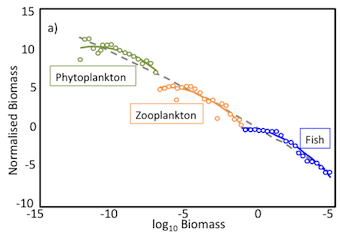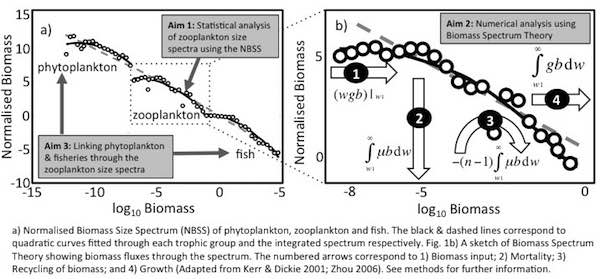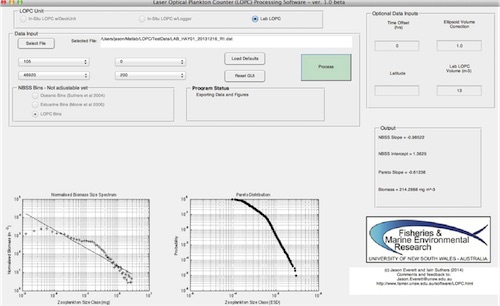
The missing link in our oceans
How zooplankton size spectra couple phytoplankton with fisheries
We are currently advertising for 2 PhD projects to commence in 2016. More details below.

We hold an ARC-Discovery Grant (2015-2017) - The missing link in our oceans: how zooplankton size spectra couple phytoplankton with fisheries - with collaborators at the University of Queensland, CSIRO and the University of British Columbia, Canada. We are currently developing a global database of zooplankton size-spectra from LED and Laser Optical Plankton Counters. We are interested in using the zooplankton size spectra to investigate how zooplankton control the transfer of energy from phytoplankton to fish at local, regional and global scales.
The Importance of Body Size
Relative to our knowledge of the oceans’ phytoplankton and fisheries, we have little understanding of the zooplankton-related processes that link them. This is extraordinary, as it is the zooplankton that graze the ocean phytoplankton (which provide ~50% of the oxygen we breathe), drive the production of our fisheries (Pauly and Christensen 1995), and play a key role in global carbon export (Buesseler et al. 2007). Irigoien et al. (2014) showed that the biomass of mid-trophic level fish (by far the most abundant fish on the planet) is an order of magnitude higher than previously thought. Our lack of knowledge of zooplankton and poorly constrained information on energy transfer through the zooplankton component of the pelagic food web helped keep this fish biomass hidden. Fundamentally, we lack adequate methods to estimate secondary production (Basedow et al. 2014) and this hampers management of marine systems. Rates of ecological processes are size-dependent (Brown 2004), especially in the ocean (Moloney and Field 1989). Applying a size-based approach to zooplankton ecology reveals processes not readily apparent from conventional taxonomic methods (Kerr and Dickie 2001) and has three key advantages:- 1) it reduces the complexity of the system from many thousands of species with different life-histories to one based on the common currency of size;
- 2) it allows the use of automated counting instruments to rapidly measure sample populations; and
- 3) it enables the development of numerical approaches, based on allometry, to express population processes in terms of trophic structure, growth, mortality and production (Baird and Suthers 2007).
Project Aims
Our aim is to use a global synthesis of zooplankton size spectra to determine zooplankton rates over broad environmental conditions and thereby characterize the missing link between phytoplankton and fisheries production. Specifically we will:- 1) Produce a global synthesis of zooplankton size spectra across a range of habitats, to generate size-based metrics of zooplankton ecological function;
- 2) Extract the ecological processes of zooplankton growth, mortality and trophic structure using the established biomass spectrum theory and;
- 3) Model archived oceanographic, fisheries and satellite data as a function of the size-based metrics (Aim 1) and ecological processes (Aim 2) of the zooplankton community.

Projects
We currently have a range of projects underway:- 1) Produce a global database of zooplankton size spectra using Optical Plankton Counter (OPC; e.g. OPC-1L and OPC-2T) and Laser Optical Plankton Counter (LOPC; e.g. LOPC-Lab, LOPC-660 and LOPC-SL) data sets (Jason Everett).
- 2) An estuarine climatology of zooplankton size spectra: Quantifying catchment drivers of the zooplankton community (Jason Everett)
- 3) Quantifying patterns of zooplankton size-spectra along a temperate to tropical gradient (Honours - Vivian Yeung).
- 4) Global size-spectra modelling: Improving representations of zooplankton to better estimate fisheries (PhD - Ryan Heneghan)
Data Collection
We have datasets from some locations around Australia, NE Canada, and the US, but there remain many gaps in these countries and elsewhere around the world. Many researchers might have collected datasets and analysed them in a regional context, but by combining them with other datasets collected over a range of environmental conditions and from areas with different productivity and fisheries yield we will provide new insights into the underlying structure and functioning of marine ecosystems. Our aim is to write a global synthesis paper investigating how size spectra varies latitudinally, seasonally, with depth and nutrient status, and its relationship to fisheries. If you wish to make your OPC/LOPC data available in this collaboration, you would be offered authorship on this paper. See this link for a pdf of the full request. If you have data you wish to contribute, please contact Jason.Prospective Students
We are currently advertising for 2 of PhD projects to commence in 2016. The applicants need to be capable of gaining an Australian Postgraduate Award through UNSW or UQ. Please contact Jason if you are considering applying and wish to discuss the projects further. We are also looking for honours students for associated projects. Please contact Jason if you are interested in discussing your ideas.OPC/LOPC Software Development
 We are also developing some software (in MATLAB) to analyse OPC and LOPC data files. The aim is to process raw OPC (.d00) and LOPC (.dat) for linear/non-linear fits of the Normalised Biomass Size Spectra (NBSS) and Pareto Distributions. Bin sizes, ESD limits, sampled volumes and depth limits would be user adjustable. The outputs are NBSS figures and CSV files. This software is still in development, but if you would like more information or be added to our email list for when a release becomes available, please contact Jason.
We are also developing some software (in MATLAB) to analyse OPC and LOPC data files. The aim is to process raw OPC (.d00) and LOPC (.dat) for linear/non-linear fits of the Normalised Biomass Size Spectra (NBSS) and Pareto Distributions. Bin sizes, ESD limits, sampled volumes and depth limits would be user adjustable. The outputs are NBSS figures and CSV files. This software is still in development, but if you would like more information or be added to our email list for when a release becomes available, please contact Jason.
